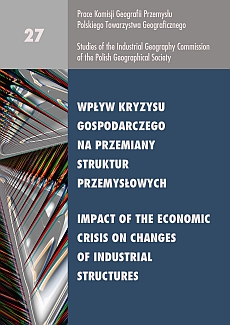Possibilities of exploitation of secondary deposits (post mining dumping grounds) as an example of changes in extractive industry
DOI:
https://doi.org/10.24917/20801653.27.16Keywords:
anthropogenic secondary deposits, Upper Silesian Coal Basin, mining wastes, post-mining dumping groundsAbstract
Polish coal mining industry produces ca. 35 millions Mg of mining wastes per year. There are ca. 250 post - mining dumping grounds in Poland, situated in three coal basins: Upper Silesian Coal Basin, Lower Silesian Coal Basin and Lublin Coal Basin. Post - mining dumping grounds may cause serious environmental hazards. Their negative influence on the natural environment, as well as risks posed to the inhabitants, calls for effective preventative measures. In the paper, presented are distribution and characteristics of post - mining dumping grounds in the Upper Silesian Coal Basin. The most important environmental issues connected with disposing of wastes are discussed. Technical possibilities of recovery of coal from waste dumps as anthropogenic secondary deposits are analyzed. An example of economical justification of recovery of coal from post - mining dumping ground is presented. Also mentioned are legal regulations connected with exploitation of waste dumps.
Downloads
Metrics
References
Gawor, Ł. (2004). Wybrane zagadnienia sozologii górniczej w Zagłębiu Ruhry i Górnośląskim Zagłębiu Węglowym (GZW) na przykładzie zwałowisk pogórniczych – studium porównawcze. Gliwice: Zeszyty Naukowe Politechniki Śląskiej, Górnictwo, 260, 97–108.
Gawor, Ł. (2011). Der Einfluss von Rechtsvorschriften auf Rekultivierung und Folgenutzung von Bergehalden am Beispiel des Oberschlesischen Steinkohlebeckens und des Ruhrgebietes. Gliwice: Wydawnictwo Politechniki Śląskiej, 72.
Gawor, Ł. (2013). Environmental impact of coal-mining wastes in Poland with regard to legal regulations. W: J. Kortnik (red.). Proceedings of 14th conference with international participation “Waste Management – GzO 13”. Krsko, ISBN 978-961-6047-79-1, 102–108.
Gawor, Ł., Main, M. (2007). Ausgewählte Umweltprobleme im Ruhrgebiet und im Oberschlesischen Kohlenbezirk (GZW) am Beispiel von Bergehalden. Veröffentlichungen von der 16. Tagung für Ingeniuergeologie und vom Forum Junge Ingenieurgeologen. Bochum, 07. bis 10. März 2007, 95–103.
Gawor, Ł., Różański, Z. (2012). Wybrane problemy rekultywacji, zagospodarowania oraz oddziaływania na środowisko zwałowisk pogórniczych w odniesieniu do uregulowań prawnych. W: Materiały z konferencji „Factum est factum” zorganizowanej przez Urząd Miejski w Bytomiu 16 stycznia 2012 roku, 15–16.
Kondracki, J. (1998). Geografia regionalna Polski. Warszawa: Wydawnictwo Naukowe PWN.
Labus, K., Skoczyńska, S. (2005). Wpływ reaktywnego dolomitu na odczyn wód odciekowych składowiska Smolnica. Zeszyty Naukowe Politechniki Śląskiej, nr 1690, Górnictwo, z. 267, 147–154.
Sikorska-Maykowska, M. (2001). Waloryzacja środowiska przyrodniczego i identyfikacja jego zagrożeń na terenie województwa śląskiego. Warszawa: Państwowy Instytut Geologiczny i Urząd Marszałkowski Województwa Śląskiego.
Strzyszcz, Z. (2004). Ocena przydatności i zasady stosowania różnorodnych odpadów do rekultywacji zwałowisk oraz terenów zdegradowanych działalnością przemysłową. Prace i Studia, 60, 82. Zabrze: Instytut Podstaw Inżynierii Środowiska PAN.
Szczepańska, J., Twardowska, I. (1999). Distribution and environmental impact of coal mining wastes in Upper Silesia, Poland. Environ. Geol., 38, 3, 249–258.
Szczepańska, J., Twardowska, I. (2004). Mining waste. W: I. Twardowska et al. Solid waste: assessment, monitoring and remediation. Amsterdam: Elsevier, 319–386.
Twardowska, I. (1981). Mechanizm i dynamika ługowania odpadów karbońskich na zwałowiskach. Prace i Studia, 25. Zabrze: Instytut Podstaw Inżynierii Środowiska PAN.
Wiggering, H. (1984). Mechanismen bei der Verwitterung aufgehaldeter Sedimente (Berge) des Oberkarbons, Dissertation. Universitäts-Gesamthochschule Essen, 228.
Wójcik, J. (1993). Przeobrażenia ukształtowania powierzchni ziemi pod wpływem górnictwa w rejonie Wałbrzycha. Wrocław: Acta Universitatis Wratislaviensis, 1557, Studia Geograficzne, 59, 5–145.
Wójcik, J. (2007). Rekultywacja hałd na terenach górniczych wałbrzyskich kopalń węgla kamiennego w latach 1960–2005. Przegląd Górniczy, 63 (3), 23–28.
Wójcik, J. (2012). Wałbrzyskie hałdy i osadniki kopalniane jako źródło surowców wtórnych – wstępne wyniki inwentaryzacji. Przegląd Geologiczny, 60, 4, 212–219.
Downloads
Published
How to Cite
Issue
Section
License
Articles are published under the terms of the Creative Commons License (CC BY-ND 4.0; Attribution– NoDerivs).

